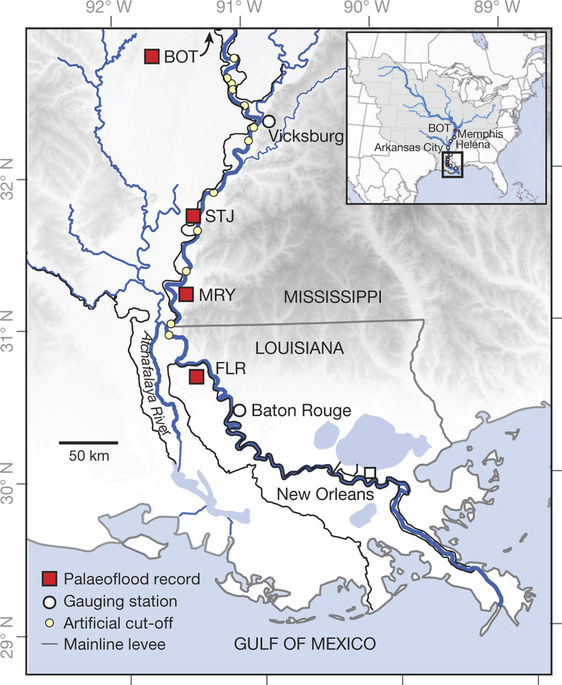Our official English website, www.x-mol.net, welcomes your
feedback! (Note: you will need to create a separate account there.)
Climatic control of Mississippi River flood hazard amplified by river engineering
Nature ( IF 50.5 ) Pub Date : 2018-04-01 , DOI: 10.1038/nature26145 Samuel E. Munoz , Liviu Giosan , Matthew D. Therrell , Jonathan W. F. Remo , Zhixiong Shen , Richard M. Sullivan , Charlotte Wiman , Michelle O’Donnell , Jeffrey P. Donnelly
Nature ( IF 50.5 ) Pub Date : 2018-04-01 , DOI: 10.1038/nature26145 Samuel E. Munoz , Liviu Giosan , Matthew D. Therrell , Jonathan W. F. Remo , Zhixiong Shen , Richard M. Sullivan , Charlotte Wiman , Michelle O’Donnell , Jeffrey P. Donnelly

|
Over the past century, many of the world’s major rivers have been modified for the purposes of flood mitigation, power generation and commercial navigation. Engineering modifications to the Mississippi River system have altered the river’s sediment levels and channel morphology, but the influence of these modifications on flood hazard is debated. Detecting and attributing changes in river discharge is challenging because instrumental streamflow records are often too short to evaluate the range of natural hydrological variability before the establishment of flood mitigation infrastructure. Here we show that multi-decadal trends of flood hazard on the lower Mississippi River are strongly modulated by dynamical modes of climate variability, particularly the El Niño–Southern Oscillation and the Atlantic Multidecadal Oscillation, but that the artificial channelization (confinement to a straightened channel) has greatly amplified flood magnitudes over the past century. Our results, based on a multi-proxy reconstruction of flood frequency and magnitude spanning the past 500 years, reveal that the magnitude of the 100-year flood (a flood with a 1 per cent chance of being exceeded in any year) has increased by 20 per cent over those five centuries, with about 75 per cent of this increase attributed to river engineering. We conclude that the interaction of human alterations to the Mississippi River system with dynamical modes of climate variability has elevated the current flood hazard to levels that are unprecedented within the past five centuries.
中文翻译:

河流工程放大密西西比河洪水灾害的气候控制
在过去的一个世纪里,为了缓解洪水、发电和商业航行,世界上许多主要河流都进行了改造。密西西比河系统的工程改造改变了河流的沉积物水平和河道形态,但这些改造对洪水灾害的影响存在争议。检测和归因河流流量的变化具有挑战性,因为仪器流量记录通常太短,无法在建立防洪基础设施之前评估自然水文变化的范围。在这里,我们表明密西西比河下游洪水灾害的多年代趋势受到气候变率动态模式的强烈调节,特别是厄尔尼诺 - 南方涛动和大西洋多年代际涛动,但是在过去的一个世纪里,人工渠道化(限制在一条直的渠道上)极大地放大了洪水的规模。我们的结果基于对过去 500 年洪水频率和震级的多代理重建,表明 100 年一遇的洪水(任何年份都有 1% 的可能性被超过的洪水)的强度增加了在这五个世纪中增加了 20%,其中约 75% 的增加归因于河流工程。我们得出的结论是,人类对密西西比河系统的改变与气候变化的动态模式的相互作用已将当前的洪水危害提升到过去五个世纪以来前所未有的水平。基于对过去 500 年洪水频率和强度的多代理重建,揭示了 100 年一遇的洪水(任何一年有 1% 的可能性被超过的洪水)的强度增加了 20%在这五个世纪中,其中约 75% 的增长归功于河流工程。我们得出的结论是,人类对密西西比河系统的改变与气候变化的动态模式的相互作用已将当前的洪水危害提升到过去五个世纪以来前所未有的水平。基于对过去 500 年洪水频率和强度的多代理重建,揭示了 100 年一遇的洪水(任何一年有 1% 的可能性被超过的洪水)的强度增加了 20%在这五个世纪中,其中约 75% 的增长归功于河流工程。我们得出的结论是,人类对密西西比河系统的改变与气候变化的动态模式的相互作用已将当前的洪水灾害提升到过去五个世纪以来前所未有的水平。其中约 75% 的增长归功于河流工程。我们得出的结论是,人类对密西西比河系统的改变与气候变化的动态模式的相互作用已将当前的洪水危害提升到过去五个世纪以来前所未有的水平。其中约 75% 的增长归功于河流工程。我们得出的结论是,人类对密西西比河系统的改变与气候变化的动态模式的相互作用已将当前的洪水危害提升到过去五个世纪以来前所未有的水平。
更新日期:2018-04-01
中文翻译:

河流工程放大密西西比河洪水灾害的气候控制
在过去的一个世纪里,为了缓解洪水、发电和商业航行,世界上许多主要河流都进行了改造。密西西比河系统的工程改造改变了河流的沉积物水平和河道形态,但这些改造对洪水灾害的影响存在争议。检测和归因河流流量的变化具有挑战性,因为仪器流量记录通常太短,无法在建立防洪基础设施之前评估自然水文变化的范围。在这里,我们表明密西西比河下游洪水灾害的多年代趋势受到气候变率动态模式的强烈调节,特别是厄尔尼诺 - 南方涛动和大西洋多年代际涛动,但是在过去的一个世纪里,人工渠道化(限制在一条直的渠道上)极大地放大了洪水的规模。我们的结果基于对过去 500 年洪水频率和震级的多代理重建,表明 100 年一遇的洪水(任何年份都有 1% 的可能性被超过的洪水)的强度增加了在这五个世纪中增加了 20%,其中约 75% 的增加归因于河流工程。我们得出的结论是,人类对密西西比河系统的改变与气候变化的动态模式的相互作用已将当前的洪水危害提升到过去五个世纪以来前所未有的水平。基于对过去 500 年洪水频率和强度的多代理重建,揭示了 100 年一遇的洪水(任何一年有 1% 的可能性被超过的洪水)的强度增加了 20%在这五个世纪中,其中约 75% 的增长归功于河流工程。我们得出的结论是,人类对密西西比河系统的改变与气候变化的动态模式的相互作用已将当前的洪水危害提升到过去五个世纪以来前所未有的水平。基于对过去 500 年洪水频率和强度的多代理重建,揭示了 100 年一遇的洪水(任何一年有 1% 的可能性被超过的洪水)的强度增加了 20%在这五个世纪中,其中约 75% 的增长归功于河流工程。我们得出的结论是,人类对密西西比河系统的改变与气候变化的动态模式的相互作用已将当前的洪水灾害提升到过去五个世纪以来前所未有的水平。其中约 75% 的增长归功于河流工程。我们得出的结论是,人类对密西西比河系统的改变与气候变化的动态模式的相互作用已将当前的洪水危害提升到过去五个世纪以来前所未有的水平。其中约 75% 的增长归功于河流工程。我们得出的结论是,人类对密西西比河系统的改变与气候变化的动态模式的相互作用已将当前的洪水危害提升到过去五个世纪以来前所未有的水平。











































 京公网安备 11010802027423号
京公网安备 11010802027423号